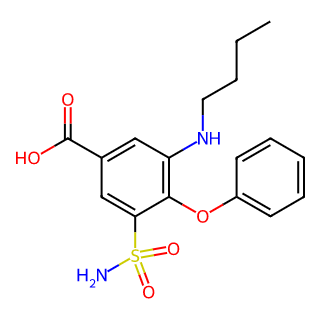- Synthetic anti-infective drugs
- Medications for the digestive system
- Antipyretic and analgesic drugs
- Medications for the blood system
- Medications for the respiratory system
- Anti-allergic drugs
- Medications for the urinary system
- Diagnostic medications
- Immunosuppressive and immunomodulatory drugs
- Vitamins and mineral supplements
- Antioxidants and medications for osteoporosis
- Antiparasitic drugs
- Ophthalmic medications
- Amino acids and their derivatives
- Dermatological medications
- Medications for the circulatory system
- Antitumor drugs
- Medications for the nervous system
- Hormonal and endocrine function-regulating drugs
- Antibiotics
- Others
CAS Number: 28395-03-1




Basic Information
Product Name: Bumetanide
Molecular Formula: C17H20N2O5S
CAS Number: 28395-03-1
EINECS Number: 249-004-6
Physical Properties
Appearance: White crystalline powder, some sources describe it as a white to light yellow to light orange solid
Melting Point: 230-231°C
Boiling Point: 571.2±60.0°C (predicted value)
Density: Approximately 1.2812 (rough estimate) or 1.3±0.1 g/cm³
Refractive Index: 1.6510 (estimated value) or 1.612
Solubility: Soluble in water, alcohol, and alkaline solutions; insoluble or sparingly soluble in acidic solutions. Specifically, it is soluble in ethanol, slightly soluble in chloroform (or dichloromethane), and insoluble or sparingly soluble in water. Some sources also indicate that it has certain solubility in organic solvents such as acetone, benzene, methanol, and propylene glycol.
Chemical Properties
Stability: Stable under normal temperature and pressure
Acid Dissociation Constant (pKa): pK1 3.6, pK2 7.7 (at 25°C)
Uses and Toxicity
Uses: Bumetanide is a mercury-free, non-benzothiazine, high-efficiency, low-toxicity new diuretic with a diuretic effect 40 times higher than furosemide. It is mainly used for the treatment of various edema and lowering blood pressure. Additionally, it is an Na+-K+-2Cl- cotransporter inhibitor with inhibitory effects on both NKCC1 and NKCC2.
Toxicity: The LD50 for intravenous injection in mice is 330 mg/kg. It is irritating to the skin, eyes, and respiratory tract and may cause damage. Therefore, appropriate protective measures should be taken when handling and storing bumetanide.

Tai Yau Street, San Po Kong, Kowloon, Hong Kong, China.



